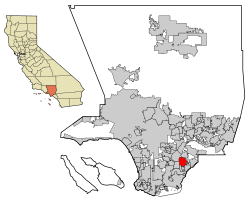2020
The 2020 United States census reported that Norwalk had a population of 102,773. The population density was 10,587.5 inhabitants per square mile (4,087.9/km2). The racial makeup of Norwalk was 20.1% White, 4.1% African American, 2.4% Native American, 13.7% Asian, 0.4% Pacific Islander, 38.3% from other races, and 21.1% from two or more races. Hispanic or Latino of any race were 71.6% of the population. [41]
The census reported that 98.8% of the population lived in households, 0.7% lived in non-institutionalized group quarters, and 0.5% were institutionalized. [41]
There were 27,835 households, out of which 42.6% included children under the age of 18, 52.7% were married-couple households, 6.8% were cohabiting couple households, 25.7% had a female householder with no partner present, and 14.8% had a male householder with no partner present. 13.1% of households were one person, and 6.5% were one person aged 65 or older. The average household size was 3.65. [41] There were 22,894 families (82.2% of all households). [42]
The age distribution was 22.0% under the age of 18, 10.4% aged 18 to 24, 28.6% aged 25 to 44, 25.2% aged 45 to 64, and 13.7% who were 65 years of age or older. The median age was 36.6 years. For every 100 females, there were 95.8 males. [41]
There were 28,455 housing units at an average density of 2,931.4 units per square mile (1,131.8 units/km2), of which 27,835 (97.8%) were occupied. Of these, 64.6% were owner-occupied, and 35.4% were occupied by renters. [41]
In 2023, the US Census Bureau estimated that the median household income was $98,709, and the per capita income was $31,989. About 7.3% of families and 9.7% of the population were below the poverty line. [43]
2010
The 2010 United States census [44] reported that Norwalk had a population of 105,549. The population density was 10,829.6 inhabitants per square mile (4,181.3/km2). The racial makeup of Norwalk was 52,089 (49.4%) White (12.3% Non-Hispanic White), [45] 4,593 (4.4%) African American, 1,213 (1.1%) Native American, 12,700 (12.0%) Asian (5.3% Filipino, 2.5% Korean, 0.9% Chinese, 0.8% Indian, 0.8% Vietnamese, 0.6% Cambodian, 0.3% Thai, 0.3% Japanese), 431 (0.4%) Pacific Islander, 29,954 (28.4%) from other races, and 4,569 (4.3%) from two or more races. Hispanic or Latino of any race were 74,041 persons (70.1%)
The Census reported that 103,934 people (98.5% of the population) lived in households, 315 (0.3%) lived in non-institutionalized group quarters, and 1,300 (1.2%) were institutionalized.
There were 27,130 households, out of which 13,678 (50.4%) had children under the age of 18 living in them, 15,190 (56.0%) were opposite-sex married couples living together, 5,045 (18.6%) had a female householder with no husband present, 2,348 (8.7%) had a male householder with no wife present. There were 1,712 (6.3%) unmarried opposite-sex partnerships, and 178 (0.7%) same-sex married couples or partnerships. 3,417 households (12.6%) were made up of individuals, and 1,631 (6.0%) had someone living alone who was 65 years of age or older. The average household size was 3.83. There were 22,583 families (83.2% of all households); the average family size was 4.10.
The population was spread out, with 29,164 people (27.6%) under the age of 18, 12,026 people (11.4%) aged 18 to 24, 30,138 people (28.6%) aged 25 to 44, 23,790 people (22.5%) aged 45 to 64, and 10,431 people (9.9%) who were 65 years of age or older. The median age was 32.5 years. For every 100 females, there were 98.5 males. For every 100 females age 18 and over, there were 95.3 males.
There were 28,083 housing units at an average density of 2,881.4 per square mile (1,112.5/km2), of which 17,671 (65.1%) were owner-occupied, and 9,459 (34.9%) were occupied by renters. The homeowner vacancy rate was 1.4%; the rental vacancy rate was 3.8%. 70,180 people (66.5% of the population) lived in owner-occupied housing units and 33,754 people (32.0%) lived in rental housing units.
During 2009–2013, Norwalk had a median household income of $60,770, with 12.9% of the population living below the federal poverty line. [45]














